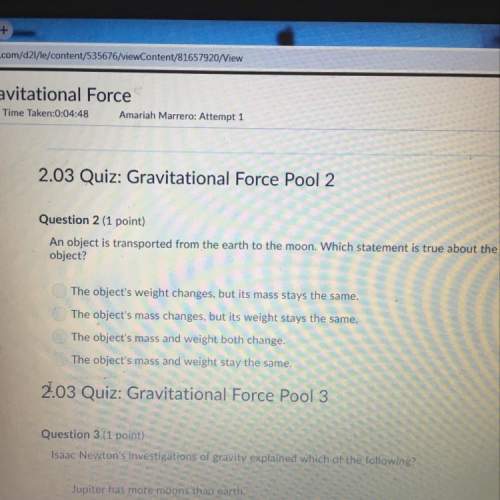
Chemistry, 03.03.2021 19:30 dontcareanyonemo
The Combustion of gasoline follows the following balanced equation.
2C8H18 + 25O2 → 18 H2O + 16 CO2 + Energy
If you have 4 moles of C8H18 (Isooctane) and 40 moles of O2 (oxygen gas) which reactant is the limiting reactant and which is the excess reactant.
Explain how you made that determination.
Include another real-world example to explain the concept of a limiting reactant.
(Your writing should include scientific terminologies such as moles, limiting reactant, excess reactant, and product)

Answers: 1
Another question on Chemistry

Chemistry, 22.06.2019 04:30
Use the periodic table to determine the electron configuration of dysprosium (dy) and americium (am) in noble-gas notation.
Answers: 1

Chemistry, 22.06.2019 10:30
Great amounts of electromagnetic energy from our sun and other bodies in space travel through space. which is a logical conclusion about these electromagnetic waves? their energy must be very their frequency must be very low these waves can travel without a medium they only travel through a vacuum of space
Answers: 2

Chemistry, 22.06.2019 17:30
98 points you will be galileo perform the experiment to determine if objects with different mass fall at the same, or different, rates in the air and in a vacuum. before you conduct your experiment, you need to form a hypothesis. a hypothesis is a prediction of what you think will happen in the experiment. the hypothesis is a statement that describes “if” a certain set of circumstances are present “then” there will be a specific result that will occur. record your hypothesis here: record the results from step one of the experiment (dropping the objects in the air): first trial: second trial: third trial: record the results from step two of the experiment (dropping the objects in a vacuum): first trial: second trial: third trial: did the experiment support your hypothesis? using the data from your experiment, describe why you believe your hypothesis was either proven or disproven. what forces were acting on the objects dropped in the air? what force was acting on the objects dropped in the vacuum? part two: comparing forces choose two forces and compare and contrast these forces. you must provide two ways that they are alike and two ways that they are different. you may make a list, write in paragraph form, or make a chart. choose two forces and compare and contrast these forces. these must be different forces than used in the prior question. provide two ways that they are similar and two ways that they are different. you may make a list, write it out, or make a chart.
Answers: 3

Chemistry, 22.06.2019 19:30
Estimate the molar mass of the gas that effuses at 1.6 times the effusion rate of carbon dioxide.
Answers: 1
You know the right answer?
The Combustion of gasoline follows the following balanced equation.
2C8H18 + 25O2 → 18 H2O + 16 CO2...
Questions


Mathematics, 12.03.2021 08:20

Computers and Technology, 12.03.2021 08:20

English, 12.03.2021 08:20

Mathematics, 12.03.2021 08:20

Mathematics, 12.03.2021 08:20



English, 12.03.2021 08:20

History, 12.03.2021 08:20


Business, 12.03.2021 08:20

Mathematics, 12.03.2021 08:30

Social Studies, 12.03.2021 08:30

Chemistry, 12.03.2021 08:30



History, 12.03.2021 08:30

Mathematics, 12.03.2021 08:30

Arts, 12.03.2021 08:30




